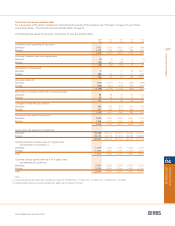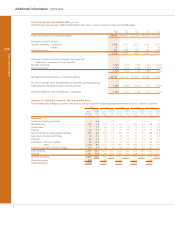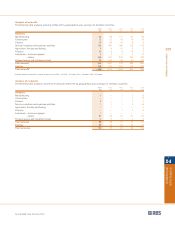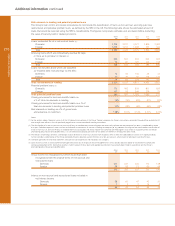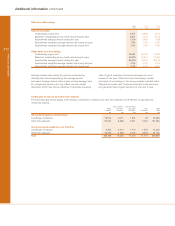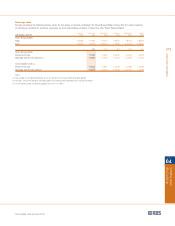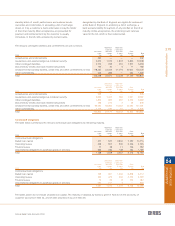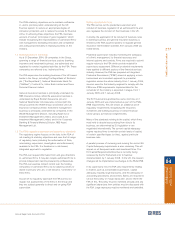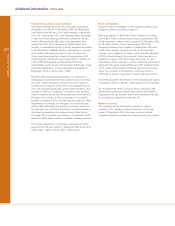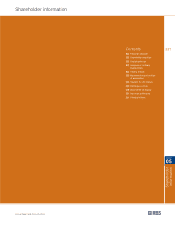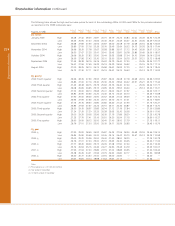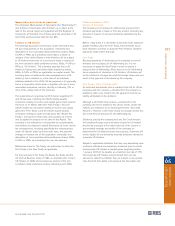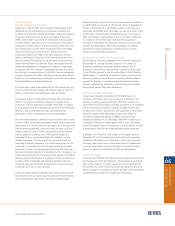RBS 2004 Annual Report Download - page 219
Download and view the complete annual report
Please find page 219 of the 2004 RBS annual report below. You can navigate through the pages in the report by either clicking on the pages listed below, or by using the keyword search tool below to find specific information within the annual report.
section
04
217
Annual Report and Accounts 2004
Additional information
Additional
information
The FSA’s statutory objectives are to maintain confidence
in, and to promote public understanding of, the UK
financial system; to secure an appropriate degree of
consumer protection; and to reduce the scope for financial
crime. In achieving these objectives, the FSA must take
account of certain “principles of good regulation” which
include recognising the responsibilities of authorised firms’
own management, facilitating innovation and competition
and acting proportionately in imposing burdens on the
industry.
1.2 Authorised firms in the Group
As at 31 December 2004, 35 companies in the Group,
spanning a range of financial services sectors (banking,
insurance and investment business), are authorised and
regulated to conduct regulated activities by the FSA. These
companies are referred to as ’authorised firms.’
The FSA supervises the banking business of the UK based
banks in the Group, including The Royal Bank of Scotland
plc (“The Royal Bank”), National Westminster Bank Plc
(“NatWest”), Coutts & Co, Ulster Bank Limited and Tesco
Personal Finance Limited.
General insurance business is principally undertaken by
RBS Insurance Group, whilst life assurance business is
undertaken by Royal Scottish Assurance plc and
National Westminster Life Assurance Limited (with the
Group’s partner, the AVIVA Group) and Direct Line Life
Insurance Company Limited. Investment management
business is principally undertaken by companies in the
Wealth Management Division, including Adam & Co
Investment Management Limited, and Coutts & Co
Investment Management Limited, and in the Corporate
Banking & Financial Markets Division, RBS Asset
Management Ltd.
1.3 The FSA’s regulatory approach and supervisory standards
The regulatory regime focuses on the risks to the FSA of
not meeting its statutory objectives and uses the full range
of regulatory tools (including the authorisation of firms,
rule-making, supervision, investigation and enforcement)
available to the FSA. It is founded on a risk based,
integrated approach to regulation.
The FSA can request information from and give directions
to, authorised firms. It may also require authorised firms to
provide independent reports prepared by professionals.
The FSA can exercise indirect control over the holding
companies of authorised firms via its statutory powers to
object to persons who are, or will become, “controllers” of
these firms.
As part of its regulatory approach the FSA carries out
regular risk assessments of the firms in the Group and
they are subject generally to direct and on-going FSA
supervision.
Setting standards for firms
The FSA carries out the prudential supervision and
conduct of business regulation of all authorised firms and
also regulates the conduct of their business in the UK.
Currently, the application of its conduct of business rules
to banking business and general insurance business is
limited but the FSA assumed powers to regulate general
insurance intermediation activities from January 2005 (as
noted below).
Prudential supervision includes monitoring the adequacy
of a firm’s management, its financial resources and
internal systems and controls. Firms are required to submit
regular returns to the FSA which provide material for
supervisory assessment. Different prudential requirements
have applied to different sectors of the financial services
industry. However, the FSA has prepared an Integrated
Prudential Sourcebook (“IPSB”) aimed at applying a more
harmonised and consistent approach to prudential
regulation across the whole industry. From 1 January 2005,
insurers were the first industry segment to comply with the
FSA’s new IPSB requirements. Implementation for the
remainder of the industry is expected in stages, from 1
January 2005 until 1 January 2008.
The EU Financial Groups Directive came into force on 1
January 2005 and was implemented as part of the FSA’s
IPSB requirements. This will create an additional set of
regulatory requirements recognising the insurance,
investment and banking business of certain financial
sector groups as financial conglomerates.
Many of the standards relating to the capital, which firms
must hold to absorb losses arising from risks to its
business, are determined by EU legislation or are
negotiated internationally. The current capital adequacy
regime requires firms to maintain certain levels of capital,
of certain specified types (or tiers), against particular
business risks.
A parallel process of reviewing and revising the current EU
Capital Adequacy requirements is also underway. This will
impact on all European banks and investment firms. The
EU Capital Requirements Directive is currently being
reviewed by the EU Parliament prior to National
implementation by 1 January 2008. In the UK, the relevant
changes will be implemented via changes to the FSA’s IPSB.
In its supervisory role, the FSA sets requirements relating
to matters such as consolidated supervision, capital
adequacy, liquidity, large exposures, and the adequacy of
accounting procedures and controls. Banks are required to
set out their policy on “large exposures” and to inform the
FSA of this. The policy must be reviewed annually and any
significant departures from policies must be discussed with
the FSA. Large exposures must be monitored and controlled.


